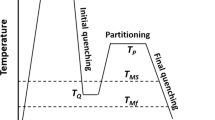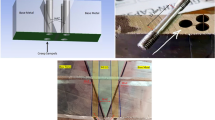Abstract
The effect of preheating temperature on crack formation, microstructure and mechanical properties of overhead crane rail steel joint by the use of shielded metal arc welding was investigated. The rail material was high carbon pearlitic rail steel. Applications of such steels require high strength and hardness at the welding zone so that the required wear resistance is obtained. However, due to the high carbon content, microstructure in the welding zone usually undergoes undesirable changes including formation of a brittle zone adjacent to fusion boundary in the rail. Welding of the rail steel with E9018-G, E11018-M, and Railroad (E12016-G) electrodes was performed without preheating and with preheating at 150, 250, and 325°C. Microstructural and mechanical properties of the weld metals and heat affected zones were investigated. Results revealed that for all the fillers, increasing preheating temperature results in decreasing the brittle zone width and prevents formation of the crack. Besides, the results showed that for the rails welded by E12016-G and E11018-M electrodes, by increasing the preheating temperature, the amounts of martensite–austenite islands and acicular ferrite decreased, and mechanical properties including impact energy significantly improved. Based on the results, an optimum preheating temperature and welding electrode are suggested.











Similar content being viewed by others
References
S. Kou, Welding Metallurgy, 2nd edn. (John Wiley & Sons, Inc., Hoboken, NJ, 2003), pp. 393–430
D. Cannon, S. Edel, S.L. Grassie, K. Sawley, Rail defects: an overview. Fatigue Fract Eng. Mater. (2003). https://doi.org/10.1046/j.1460-2695.2003.00693.x
H. Jun, J. Seo, I. Jeon, S. Lee, Y. Chang, Fracture and fatigue crack growth analyses on a weld-repaired railway rail. Eng. Fail. Anal. (2016). https://doi.org/10.1016/j.engfailanal.2015.11.014
A. Allie, H. Aglan, M. Fateh, Mechanical and fracture analysis of welded pearlitic rail steels. J Mech Mater Struct. 5, 263–276 (2010)
A. Fallahi, K. Jafarpur, M. Nami, Analysis of welding conditions based on induced thermal irreversibilities in welded structures: cases of welding sequences and preheating treatment. Sci Iran (2011). https://doi.org/10.1016/j.scient.2011.05.030
X. Yu, L. Feng, S. Qin, Y. Zhang, Y. He, Fracture analysis of U71Mn rail flash-butt welding joint. Case Stud. Eng. Fail Anal. (2015). https://doi.org/10.1016/j.csefa.2015.05.001
K. Lee, A. Polycarpou, Wear of conventional pearlitic and improved bainitic rail steels. Wear (2005). https://doi.org/10.1016/j.wear.2005.02.058
Y. Chen, F. Lawrence, C. Barkan, J. Dantzig, Weld defect formation in rail thermite welds. Part F J. Rail Rapid Transit. (2006). https://doi.org/10.1243/0954409JRRT44
H. Aglan, Z. Liu, M. Hassan, M. Fateh, Mechanical and fracture behavior of bainitic rail steel. J. Mater. Process. Technol. (2004). https://doi.org/10.1016/j.jmatprotec.2004.04.073
W. Zhao, Y. Zou, K. Matsuda, Z. Zou, Corrosion behavior of reheated CGHAZ of X80 pipeline steel in H2S-containing environments. Mater. Des. (2016). https://doi.org/10.1016/j.matdes.2016.03.036
H. Zhang, S. Ohsaki, S. Mitao, M. Ohnuma, K. Hono, Microstructural investigation of white etching layer on pearlite steel rail. Mater. Sci. (2006). https://doi.org/10.1016/j.msea.2006.01.033
J. Lee, M. Hon, G. Cheng, The intermediate transformation of Mn-Mo-Nb steel during continuous cooling. J. Mater. Sci. 22, 2767–2777 (1987)
E. Gharibshahiyan, A.H. Raouf, N. Parvin, M. Rahimian, The effect of microstructure on hardness and toughness of low carbon welded steel using inert gas welding. Mater. Des. (2011). https://doi.org/10.1016/j.matdes.2010.11.056
L. Fan, D. Zhou, T. Wang, S. Li, Q. Wang, Tensile properties of an acicular ferrite and martensite/austenite constituent steel with varying cooling rates. Mater. Sci. Eng. (2014). https://doi.org/10.1016/j.msea.2013.10.037
L. Fan, T. Wang, Z. Fu, S. Zhang, Q. Wang, Effect of heat-treatment on-line process temperature on the microstructure and tensile properties of a low carbon Nb-microalloyed steel. Mater. Sci. Eng. (2014). https://doi.org/10.1016/j.msea.2014.04.027
K. Million, R. Datta, H. Zimmermann, Effects of heat input on the microstructure and toughness of the 8 MnMoNi 5 5 shape-welded nuclear steel. J. Nucl. Mater. (2005). https://doi.org/10.1016/j.jnucmat.2004.10.093
G.K. Padhy, Y. Komizo, Diffusible hydrogen in steel weldments: a status review. Trans. Join. Weld. Res. Inst. 42, 39–62 (2013)
A.T. Hanzaei, S.P.H. Marashi, E. Ranjbarnodeh, The effect of hydrogen content and welding conditions on the hydrogen induced cracking of the API X70 steel weld. Int. J. Hydrog. Energy. (2018). https://doi.org/10.1016/j.ijhydene.2018.03.216
Y. Zhai, B. Huang, Z. Zhang, X. Mao, Z. Zhao, Effect of preheating on welding cold crack sensitivity of China low activation martensitic steel. Fusion Eng. Des. (2018). https://doi.org/10.1016/j.fusengdes.2018.05.071
E. Bayraktar, D. Kaplan, Mechanical and metallurgical investigation of martensite–austenite constituents in simulated welding conditions. J. Mater. Process. Technol. (2004). https://doi.org/10.1016/j.jmatprotec.2004.04.021
N. Huda, A.R. Midawi, J. Gianetto, R. Lazor, A.P. Gerlich, Influence of martensite-austenite (MA) on impact toughness of X80 line pipe steels. Mater. Sci. Eng. (2016). https://doi.org/10.1016/j.msea.2016.03.095
Acknowledgements
This work was supported by the Khouzestan Steel Company (KSC), and Drilling Center of Excellence and Research Center, Shahid Chamran University of Ahvaz, Ahvaz, Iran. The authors also appreciate the financial support provided by Shahid Chamran University of Ahvaz, Iran, through the Grant No. SCU.EM98.322.
Author information
Authors and Affiliations
Corresponding author
Additional information
Publisher's Note
Springer Nature remains neutral with regard to jurisdictional claims in published maps and institutional affiliations.
Rights and permissions
About this article
Cite this article
Faghfouri, M., Ranjbar, K., Dehmolaei, R. et al. Preventing Crack Formation at the Vicinity of the Fusion Zone in the Welding of Crane Rail Steel by Preheating Treatment. Metallogr. Microstruct. Anal. 9, 541–552 (2020). https://doi.org/10.1007/s13632-020-00665-y
Received:
Revised:
Accepted:
Published:
Issue Date:
DOI: https://doi.org/10.1007/s13632-020-00665-y




